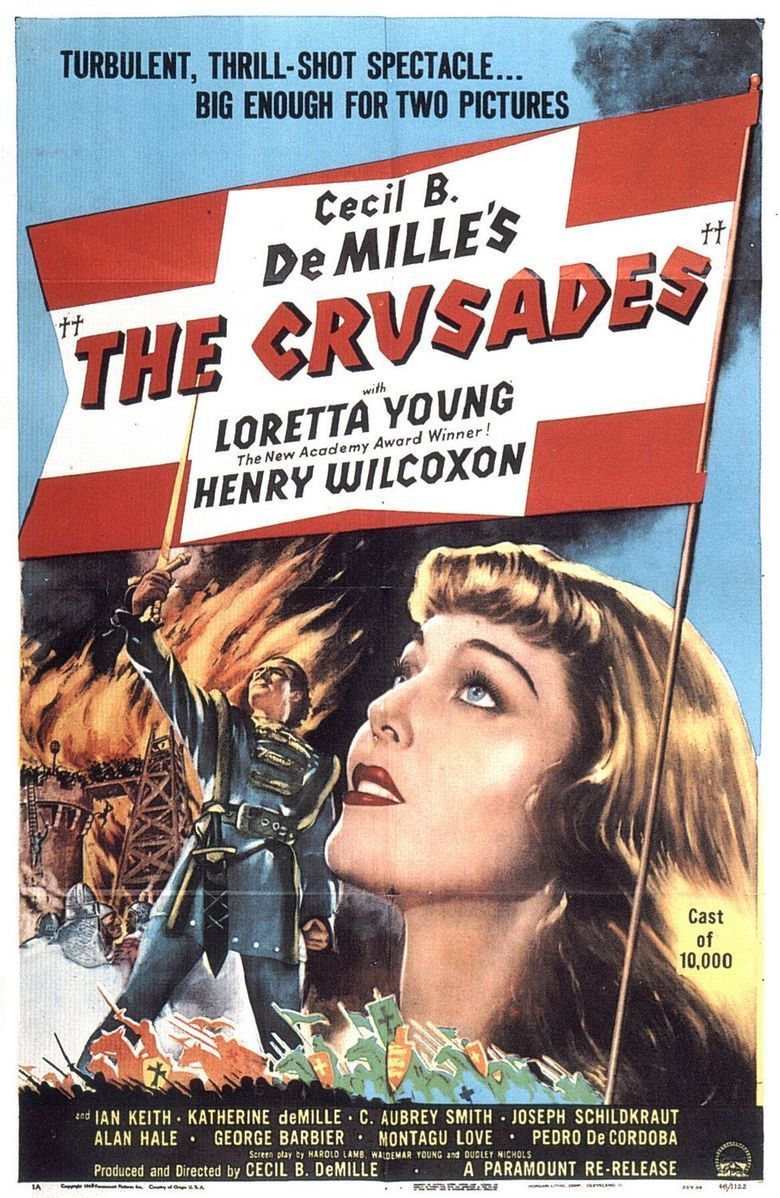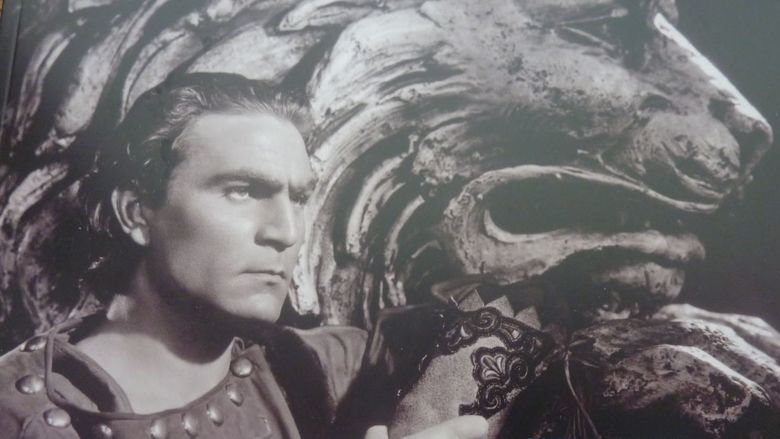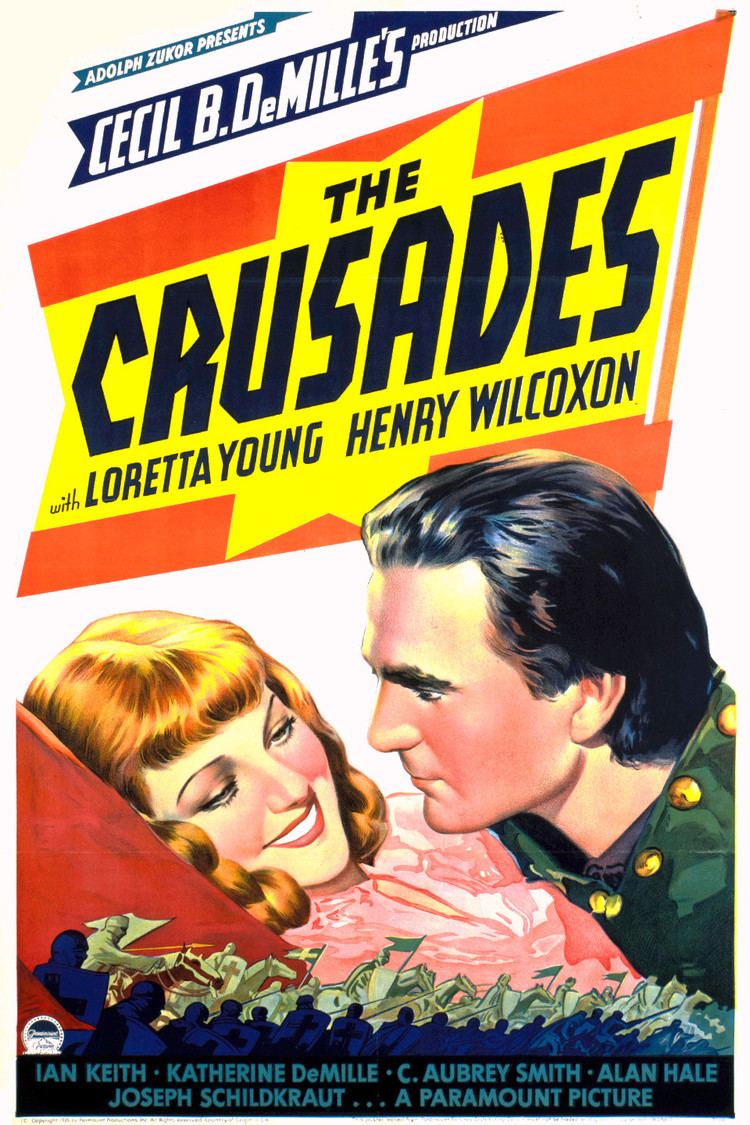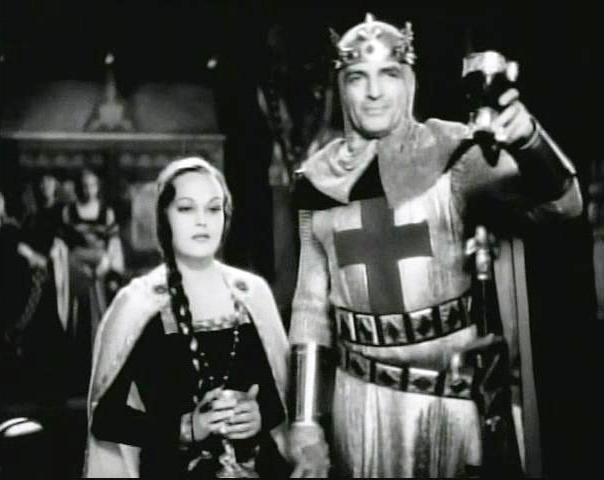The Crusades (film)
6.8 /10 1 Votes
Producer Cecil B. DeMille Duration Country United States | 6.8/10 IMDb Genre Adventure, Drama, History Language English | |||||||||||||||||||||||||||||||||
 | ||||||||||||||||||||||||||||||||||
Release date August 21, 1935 Cast (Berengaria, Princess of Navarre), (Richard, King of England), (Saladin), C. Aubrey Smith (The Hermit), (Alice, Princess of France), (Conrad, Marquis of Montferrat)Similar movies J. Edgar , My Week with Marilyn , Malcolm X , The Life of Emile Zola , Mandela: Long Walk to Freedom , Man of a Thousand Faces | ||||||||||||||||||||||||||||||||||
The Crusades is a 1935 American historical adventure film produced and directed by Cecil B. DeMille, and originally released by Paramount Pictures. It stars Loretta Young as Berengaria of Navarre and Henry Wilcoxon as Richard I of England. It was nominated for an Academy Award for Best Cinematography (Victor Milner) as well as for Best Foreign Film at the Venice Film Festival in 1935.
Contents

Plot

The film takes many of its elements and main characters from the Third Crusade, which was prompted by the Saracen capture of Jerusalem and the crusader states in the Holy Land in A.D. 1187. The character of King Richard the Lionheart is established early as a man of action but little thought. A hermit arrives preaching a great Crusade to bring Jerusalem back into Christian hands. Richard enlists in order, cynically, to get out of an arranged betrothal to Princess Alice of France. A plot is laid against Richard's life by his brother Prince John and Conrad, Marquis of Montferrat. En route to the war, Richard meets Berengaria, Princess of Navarre and—again cynically—marries her in exchange for food for his men. Berengaria accompanies Richard to the Holy Land.

During the Crusaders' attempts to get past the walls of Acre, the allies assemble in conference, but in disarray. Richard's ally, Philip II of France, is enraged at Richard's rejection of his sister Alice, but Richard defies Philip and the other troubled allies by proclaiming Berengaria Queen of England. The Christian leaders meet in parley with the Muslim Sultan and leader Saladin. Saladin is struck by Berengaria's beauty and bravery in supporting her husband. However, he rejects any truce with the Crusaders, and declares that the arrogant Richard will "never pass the gates of Jerusalem."

Berengaria is fearful that her presence in camp is causing disloyalty among Richard's allies, in particular the powerful French King Philip, and may harm their holy quest. Seeking death, she enters no man's land between the lines, only to be wounded and captured by the forces of Saladin. The hermit, the Christian "holy man" who had preached the Crusade, also is captured. Saladin escapes the siege, and brings Berengaria to Jerusalem to care for her, with admiration and growing affection. Not knowing this, and inflamed to save the Queen of England, Richard and the Crusaders storm Acre, then battle their way to Jerusalem.

The internal plot against Richard's life is hatched by Conrad and disloyal soldiers. Conrad reveals his plot to Saladin, expecting to be rewarded. Berengaria offers herself to Saladin if he will intervene and save Richard's life. Saladin, moved by Berengaria's loyalty to Richard and appalled at Conrad's perfidy, orders Conrad to be summarily executed and Richard to be rescued. With their forces exhausted, Richard and Saladin agree to a truce, and Berengaria is freed. The gates of Jerusalem are opened to all Christians with the exception of Richard, in keeping with Saladin’s proviso. Forlorn, Richard only belatedly appreciates Berengaria’s loyalty and love for him. Richard encounters Berengaria on her way to the Holy City. He admits his mistakes, but Berengaria proceeds alone toward Jerusalem, their future together unknown.
Cast
Musical score
The film is noted for its spectacular film score, much of it uncredited. It includes the Hymn of Joy, music by Rudolph G. Kopp and lyrics by Harold Lamb; Soldier's Song, by Kopp and Lamb; and the stirring Song of the Crusades, music by Richard A. Whiting and Kopp, lyrics by Lamb and Leo Robin, and special choral lyrics by Jeanie Macpherson, which introduces the film and is used as the crusaders march to battle.
Reception
Andre Sennwald of The New York Times called the film a "grand show" and "two hours of tempestuous extravaganza". Sennwald also praised the "superbly managed" staging of the attack on the city of Acre and cited "excellent performances" all around, stating in conclusion, "It is rich in the kind of excitement that pulls an audience irresistibly to the edge of its seat." Variety also praised the film, writing, "Probably only DeMille could make a picture like Crusades – and get away with it. It's long, and the story is not up to some of his previous films, but the production has sweep and spectacle." Film Daily declared it "one of the best DeMille pictures ... The battle scenes are among the most thrilling made since the inception of talking pictures." John Mosher of The New Yorker was less enthused, finding it "rather mild De Mille" that "doesn't compare by a long shot with many other scenes in the Master's collection. There is nothing in the film as astonishing as his Passing through the Red Sea, nothing as amazingly ornamental as his arenas of Imperial Rome." Mosher did praise Wilcoxon's performance, however, especially in his scenes with Young. Similarly reserved, Graham Greene writing for The Spectator described it as "a very long film" with a "stuffy horsehair atmosphere of beards and whiskers", and criticized its historical accuracy as "a little quiet fun at the expense of Clio" with as "complete [a] lack of period sense" as "decorated mid-Victorian Bibles". Greene did praise de Mille's "childlike eye for details", however, and characterized the set-piece scenes (e.g. the cavalry charge and the storming of Acre) as "scenes of real executive genius".
Cultural context
Lorraine K. Stock writes in Hollywood in the Holy Land, in her chapter "Now Starring in the Third Crusade" that Crusading films have been used by European and American countries to spread a political or cultural agenda. One way with which this is done is through the main Crusading "heroes" such as Richard the Lionhearted and main antagonist Saladin. Many films have used the relationship between Richard I and Saladin. In this particular film the relationship between Richard I and Saladin is connected not only by the conflict of the Crusade but "an improbable, if entertaining, erotic triangle" with Berengaria of Navarre. Stock notes that this relationship and the events which occur can be seen as a reaction to events after the First World War and especially America's isolationism. For example, Richard the Lionheart at first does not want to get married, so he goes on Crusade despite showing signs of not being religious. Berengaria can also be seen as a "medieval League of Nations" when negotiations between Saladin and Richard I occur at the end of the movie.
A main concern for such films is the way Muslims and Crusaders are portrayed. Throughout the film Stock notes that there are a negative portrayals of Saladin and the Muslims. For instance Stock notes that the Crusaders are all dressed in mail armor with the cross upon their chests while Saladin and the Saracens are dressed mainly in "flowing robes of luxury fabrics" and "silken sashes". The Saracens shown as oriental but also "exotically feminized" according to Stock. Another scene has the Saracens shoot a Crusader messenger, who demand surrender of the city, with one of them wearing a helmet with devil horns upon it. There are other moments with which the Europeans mention devilry or call Muslims infidels. Stock says DeMille "establish the stereotypes of Richard and Saladin that subsequent films would repeat…".
However Saladin is also depicted as an honorable man. In "Islam Muslims and Arabs in the Popular Hollywood Cinema", Anton K. Kozlovic writes "The Crusades was not as enthusiastically received in the West as DeMille would have liked (Bichard 2004, 292) probably because it showed the good and noble side of the Muslims and contrasted it with the darker deeds of Christianity". Saladin in the film refuses to help assassinate Richard I and in fact sends out help to prevent Richard from being killed by the treacherous other Europeans. Kozlovic also notes that when Saladin offers peace to the "foes of Islam", Richard responds by drawing his sword "and saying 'We are going to slaughter you!'". Kozlovic sees DeMille's film as a challenge to the stereotypical norm and negative picture painted of Muslim in Crusader films specifically.
Home Video Release
This film, along with The Sign of the Cross, Four Frightened People, Cleopatra and Union Pacific, was released on DVD in 2006 by Universal Studios as part of The Cecil B. DeMille Collection.
References
The Crusades (film) WikipediaThe Crusades (film) IMDbThe Crusades (film) themoviedb.org
